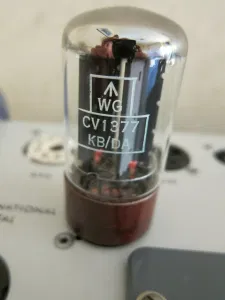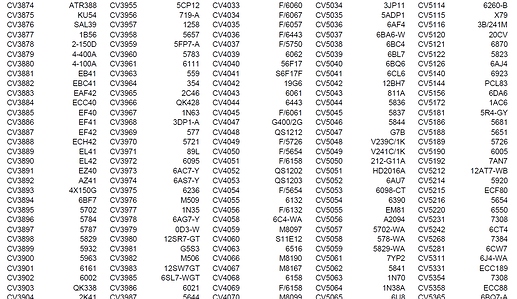
Всё для бояр!
Таблица перевода CV кодов ламп в “нормальные” маркировки, в формате PDF.
Два объяснения, что такое CV:
CV marked valves
CV most probably stands for Common Valve, though the actual reason is vague (the only actual references to this I have found to date appear in document TVC285 of the Inter-Service Technical Valve Committee which discusses “[w]hen the Common Valve system was instituted…”, and also in Admiralty Fleet Order A.F.O. 648/44 “Valves - thermionic and similar stores for W/T radar, cinema, etc. services - accounting and storing - institution of new item, F.4., under vote 8/11” which states that valves have been assigned “'C.V. (Common Valve)” numbers). CV numbers were applied to valves used by the British Services, gradually replacing the Army, Navy and Air Force nomenclature in use at that time. In addition a number of valves used by the GPO were given CV numbers. CV numbers have been around since the early 1940’s - CV1 was listed in the “Service List of Valves for Special Purposes” published by the Inter-Service Technical Valve Committee in 1941, though at that time their own Service List of Preferred Valves does not appear to have had any CV valves in. Certainly they were in use in 1942 as the specification sheet for the CV44 is dated 9/4/42, and also the type approval date of CV8 is given as 1942.
British CV naming system
This system prefixes a three- or four-digit number with the letters “CV”, meaning “civilian valve” i.e. common to all three armed services. It was introduced during the Second World War to rationalise the previous nomenclatures maintained separately by the War Office/Ministry of Supply, Admiralty and Air Ministry/Ministry of Aircraft Production on behalf of the three armed services (e.g. “ACR~”, “AR~”, “AT~”, etc. for CRTs, receiving and transmitting valves used in army equipments, “NC~”, “NR~” and “NT~” similarly for navy equipments and “VCR~”, “VR~” and “VT~” etc. for air force equipments), in which three separate designations could in principle apply to the same valve (which often had at least one prototype commercial designation as well). These numbers generally have identical equivalents in both the North American, RETMA, and West European, Mullard–Philips, systems but they bear no resemblance to the assigned “CV” number.
Examples:
- CV1988 = 6SN7GT = ECC32 (not a direct equivalent as heater current is different and bulb is larger)
- CV2729 = E80F – An SQ version of EF80 but with revised pin-out and a base screen substituted for the RF screen
- CV4007 = E91AA – SQ version of 6AL5
- CV4010 = E95F – SQ version of 6AK5 or EF95
- CV4014 = M8083 – SQ version of EF91 or 6AM6 (The ‘M’ in the part number denotes that it was developed by the military)
Пример:
CV Register.pdf (140.0 КБ)
Как теперь модно писать - ставьте лайки, подписывайтесь на канал. 
